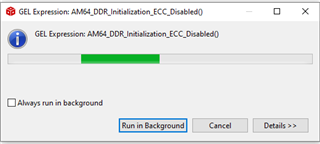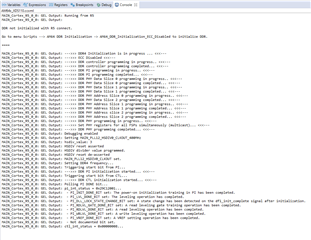Other Parts Discussed in Thread: SYSCONFIG
Hi,
I'm loading a DSP FW on R5 processor from the Linux processor as described at https://software-dl.ti.com/processor-sdk-linux/esd/docs/08_00_00_21/linux/Foundational_Components_IPC64x.html
Running "echo start > /sys/class/remoteproc/remoteproc0/state" command, as detailed in section 4.4, I get the following error:

Running the same command with cmpiled RP messages example, ipc_rpmsg_echo_linux, I get a valid response:

My FW runs appropriate on the R5 when I load it by the CCS.
This is my linker file:
/* This is the stack that is used by code running within main()
* In case of NORTOS,
* - This means all the code outside of ISR uses this stack
* In case of FreeRTOS
* - This means all the code until vTaskStartScheduler() is called in main()
* uses this stack.
* - After vTaskStartScheduler() each task created in FreeRTOS has its own stack
*/
--stack_size=16384
/* This is the heap size for malloc() API in NORTOS and FreeRTOS
* This is also the heap used by pvPortMalloc in FreeRTOS
*/
--heap_size=32768
-e_vectors /* This is the entry of the application, _vector MUST be plabed starting address 0x0 */
/* This is the size of stack when R5 is in IRQ mode
* In NORTOS,
* - Here interrupt nesting is enabled
* - This is the stack used by ISRs registered as type IRQ
* In FreeRTOS,
* - Here interrupt nesting is disabled
* - This is stack that is used initally when a IRQ is received
* - But then the mode is switched to SVC mode and SVC stack is used for all user ISR callbacks
* - Hence in FreeRTOS, IRQ stack size is less and SVC stack size is more
*/
__IRQ_STACK_SIZE = 256;
/* This is the size of stack when R5 is in IRQ mode
* - In both NORTOS and FreeRTOS nesting is disabled for FIQ
*/
__FIQ_STACK_SIZE = 256;
__SVC_STACK_SIZE = 4096; /* This is the size of stack when R5 is in SVC mode */
__ABORT_STACK_SIZE = 256; /* This is the size of stack when R5 is in ABORT mode */
__UNDEFINED_STACK_SIZE = 256; /* This is the size of stack when R5 is in UNDEF mode */
SECTIONS
{
/* This has the R5F entry point and vector table, this MUST be at 0x0 */
.vectors:{} palign(8) > R5F_VECS
/* This has the R5F boot code until MPU is enabled, this MUST be at a address < 0x80000000
* i.e this cannot be placed in DDR
*/
GROUP {
.text.hwi: palign(8)
.text.cache: palign(8)
.text.mpu: palign(8)
.text.boot: palign(8)
.text:abort: palign(8) /* this helps in loading symbols when using XIP mode */
} > R5F_TCMA
/* This is rest of code. This can be placed in DDR if DDR is available and needed */
GROUP {
.text: {} palign(8) /* This is where code resides */
.rodata: {} palign(8) /* This is where const's go */
} > DDR_1
GROUP {
/* This is the resource table used by linux to know where the IPC "VRINGs" are located */
.resource_table: {} palign(4096)
} > DDR_0
/* This is rest of initialized data. This can be placed in DDR if DDR is available and needed */
GROUP {
.data: {} palign(8) /* This is where initialized globals and static go */
} > DDR_1
/* This is rest of uninitialized data. This can be placed in DDR if DDR is available and needed */
GROUP {
.bss: {} palign(8) /* This is where uninitialized globals go */
RUN_START(__BSS_START)
RUN_END(__BSS_END)
.sysmem: {} palign(8) /* This is where the malloc heap goes */
.stack: {} palign(8) /* This is where the main() stack goes */
} > DDR_1
/* This is where the stacks for different R5F modes go */
GROUP {
.irqstack: {. = . + __IRQ_STACK_SIZE;} align(8)
RUN_START(__IRQ_STACK_START)
RUN_END(__IRQ_STACK_END)
.fiqstack: {. = . + __FIQ_STACK_SIZE;} align(8)
RUN_START(__FIQ_STACK_START)
RUN_END(__FIQ_STACK_END)
.svcstack: {. = . + __SVC_STACK_SIZE;} align(8)
RUN_START(__SVC_STACK_START)
RUN_END(__SVC_STACK_END)
.abortstack: {. = . + __ABORT_STACK_SIZE;} align(8)
RUN_START(__ABORT_STACK_START)
RUN_END(__ABORT_STACK_END)
.undefinedstack: {. = . + __UNDEFINED_STACK_SIZE;} align(8)
RUN_START(__UNDEFINED_STACK_START)
RUN_END(__UNDEFINED_STACK_END)
} > DDR_1
/* Sections needed for C++ projects */
GROUP {
.ARM.exidx: {} palign(8) /* Needed for C++ exception handling */
.init_array: {} palign(8) /* Contains function pointers called before main */
.fini_array: {} palign(8) /* Contains function pointers called after main */
} > DDR_1
/* General purpose user shared memory, used in some examples */
.bss.user_shared_mem (NOLOAD) : {} > USER_SHM_MEM
/* this is used when Debug log's to shared memory are enabled, else this is not used */
.bss.log_shared_mem (NOLOAD) : {} > LOG_SHM_MEM
/* this is used only when IPC RPMessage is enabled, else this is not used */
.bss.ipc_vring_mem (NOLOAD) : {} > RTOS_NORTOS_IPC_SHM_MEM
}
/*
NOTE: Below memory is reserved for DMSC usage
- During Boot till security handoff is complete
0x701E0000 - 0x701FFFFF (128KB)
- After "Security Handoff" is complete (i.e at run time)
0x701F4000 - 0x701FFFFF (48KB)
Security handoff is complete when this message is sent to the DMSC,
TISCI_MSG_SEC_HANDOVER
This should be sent once all cores are loaded and all application
specific firewall calls are setup.
*/
MEMORY
{
R5F_VECS : ORIGIN = 0x00000000 , LENGTH = 0x00000040
R5F_TCMA : ORIGIN = 0x00000040 , LENGTH = 0x00007FC0
R5F_TCMB0 : ORIGIN = 0x41010000 , LENGTH = 0x00008000
/* when using multi-core application's i.e more than one R5F/M4F active, make sure
* this memory does not overlap with other R5F's
*/
MSRAM : ORIGIN = 0x70080000 , LENGTH = 0x40000
/* This section can be used to put XIP section of the application in flash, make sure this does not overlap with
* other CPUs. Also make sure to add a MPU entry for this section and mark it as cached and code executable
*/
FLASH : ORIGIN = 0x60100000 , LENGTH = 0x80000
/* when using multi-core application's i.e more than one R5F/M4F active, make sure
* this memory does not overlap with other R5F's
*/
/* Resource table must be placed at the start of DDR_0 when R5 cores are early booting with Linux */
DDR_0 : ORIGIN = 0xA0100000 , LENGTH = 0x1000
DDR_1 : ORIGIN = 0xA0101000 , LENGTH = 0xEFF000
/* shared memory segments */
/* On R5F,
* - make sure there is a MPU entry which maps below regions as non-cache
*/
USER_SHM_MEM : ORIGIN = 0xA5000000, LENGTH = 0x80
LOG_SHM_MEM : ORIGIN = 0xA5000000 + 0x80, LENGTH = 0x00004000 - 0x80
RTOS_NORTOS_IPC_SHM_MEM : ORIGIN = 0xA5004000, LENGTH = 0x0000C000
LINUX_IPC_SHM_MEM : ORIGIN = 0xA0000000 , LENGTH = 0x100000
}
Please advise.
Thanks,
Dekel




